Imagine a peaceful backyard on a spring morning. You might see a robin hopping across the lawn, looking for the perfect worm. This shows how many birds eat worms and worm-like creatures. From woodpeckers and nuthatches to starlings and bluebirds, many birds enjoy this protein-rich food.
This helps keep our ecosystems balanced. It’s a key part of nature’s cycle.
Key Takeaways
- A wide range of wild bird species, including woodpeckers, nuthatches, robins, starlings, owls, and bluebirds, are known to eat worms.
- Worms are a valuable food source for birds, providing high protein content and easy accessibility by simply poking their bills into the ground.
- Birds have different approaches to finding and consuming worms, with some having specialized bills and others being more generalized in their invertebrate prey.
- Worms play a crucial role in the delicate balance of ecosystems, and birds that eat them contribute to natural pest control and soil health.
- Observing birds in your backyard can provide insights into their feeding habits and the important ecological relationships they share with worms and other invertebrates.
Introduction to Vermivores
The term “vermivore” means animals that eat worms and similar creatures. Birds love worms because they are high in protein and easy to find. Many bird species are vermivores, but they hunt for worms in different ways.
The Meaning of Vermivores
Vermivores are animals that mainly eat worms and other invertebrates. This includes many bird species, some mammals, reptiles, and amphibians. Finding and eating worms is key for these animals to survive in places where worms are common.
Why Birds Like Worms
Birds like worms for a few reasons. Worms are full of protein, which birds need for growth, health, and making babies. Also, birds can easily find worms by sticking their beaks into the soil.
“Worms are an excellent source of protein, which is essential for growth, maintenance, and reproduction in birds.”
Many bird species are vermivores, showing how important worms are in their diet. Birds like woodpeckers, nuthatches, robins, and bluebirds have special ways to find and eat worms.
The Truth About Mealworms
Most vermivores love fresh worms for their taste and nutrition. But, dead worms or freeze-dried mealworms can also work well as a worm substitute for birds. Mealworms are actually the young stage of the darkling beetle, not true worms. They have six legs, unlike worms, but look similar. This makes them suitable for birds that eat worms.
Many birds like bluebirds and chickadees eat mealworms. Live ones are more tempting, but dried ones are cheaper and easier to store. Experts suggest offering mealworms as a treat, not the main food, to keep birds healthy.
To cut costs, you can make your own feeder or use old items. Emma Greig, an expert in bird behavior, says it’s key to keep mealworms healthy for feeding birds.
“Over 50 tons of live mealworms are shipped out per month by one Chinese insect farm, and the same farm ships out over 200,000 tons of dried mealworms per year.”
In Asia and Europe, people eat mealworms too. They’re often raised on wheat or oat bran. At Stanford University, researchers feed mealworms polystyrene to show how adaptable they are. Live mealworms are better for baby birds, and many rehabbers add nutritional powder to them.
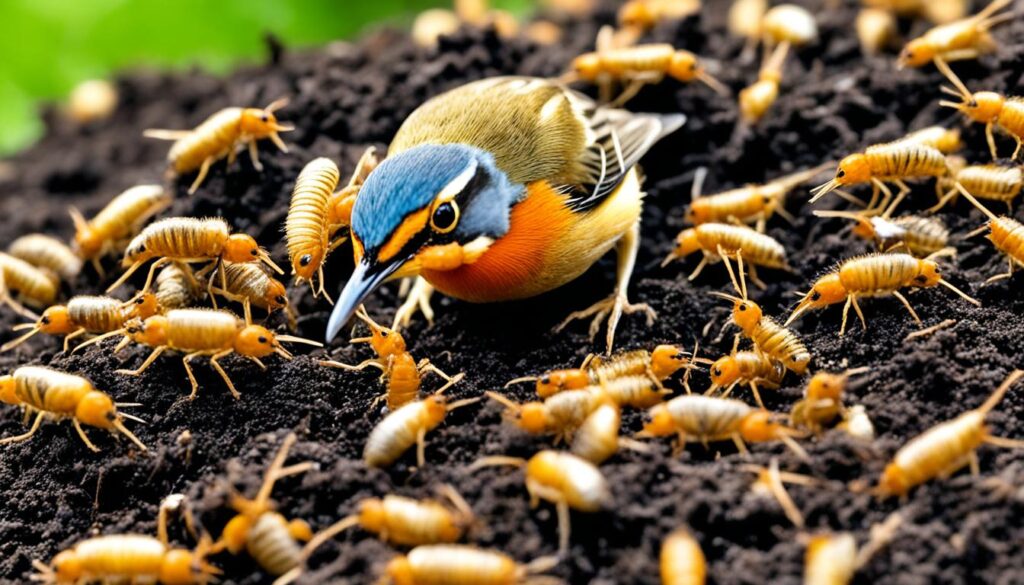
Common Vermivore Bird Species
Many wild birds love to eat worms. Some top examples include woodpeckers, nuthatches, robins, starlings, owls, and bluebirds. These vermivore bird species, or worm-eating birds, have varied avian feeding habits that go beyond their main diets.
Woodpeckers
Woodpeckers are known for hunting insects and eating berries. They also enjoy mealworms as part of their omnivorous diet.
Nuthatches
Nuthatches love tree nuts but also eat mealworms, insects, and spiders.
Robins
Robins are famous for eating earthworms. They also enjoy beetles, caterpillars, snails, and other invertebrates.
Starlings
Starlings are omnivorous birds. They eat caterpillars, mealworms, and beetles. They also like fruits, vegetables, grains, and nuts.
Owls
Owls eat small mammals and reptiles, but they also have earthworms, snails, and crabs on their menu.
Bluebirds
Bluebirds like mealworms, both dried and fresh. But, they should not eat earthworms. They can’t digest them well.
Seedeaters: Birds That Eat Seeds
Many wild birds eat worms and other small animals. But, there are birds called seedeaters that mainly eat seeds. They have strong, pointed bills perfect for cracking open seeds. These birds love seeds for their taste, crunch, and the nutrients they provide.
Seeds give them the energy they need for flying, migrating, and staying healthy. This is especially true during the cold winter months.
Why Birds Like Seeds
Seeds are a key food for many birds. They are full of proteins, fats, and carbs that birds need to stay active. The hard seed shells also give birds a nice crunch.
There are many types of seeds, like sunflower and nyjer seeds. This lets birds pick their favorite tastes and textures.
Caching Behavior of Seedeaters
Birds can store seeds for later by caching. They hide seeds in places like tree bark and gutters near bird feeders. This way, they have food saved for when it’s scarce.
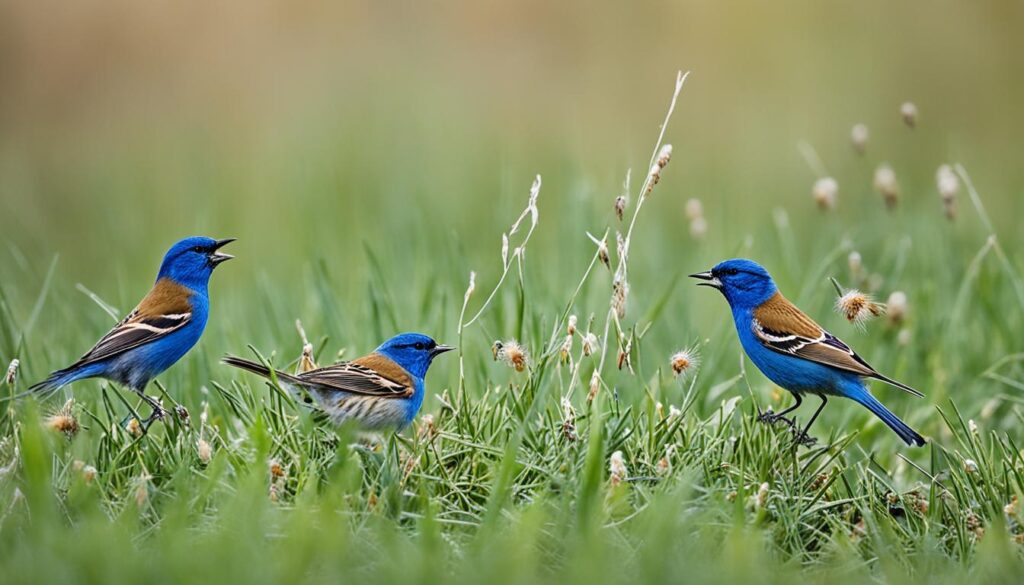
“Sunflower seeds are the mainstay for most backyard bird feeders, attracting a wide variety of birds.”
Notable Seedeater Bird Species
The world of birds is full of different species that eat a wide variety of foods. Finches, cardinals, chickadees, redpolls, and juncos are some of the most interesting. They love to eat different seeds, showing how adaptable and unique they are.
Finches
Finches enjoy eating sunflower seeds and nyjer, but they also like corn and millet. Their special beaks help them open and get to the seeds inside these popular bird foods. Finches are often seen at backyard feeders, moving from feeder to feeder to eat their favorite seeds.
Cardinals
Cardinals are known for their bright colors and beautiful songs. They eat berries and many types of seeds, like black oil sunflower seeds, suet, and nyjer seed. Their strong beaks let them open the hard shells of these seeds, making them fun to watch at feeders.
Chickadees
Chickadees are common in many backyards. In summer, they eat insects, but in winter, they love seeds like sunflower seeds and peanuts. These seeds help them stay warm and active during the cold months.
Redpolls
Redpolls prefer nyjer seed and proso millet because of their small beaks. These small birds can be seen in large groups at backyard feeders, picking out the tiny seeds they like.
Juncos
Juncos eat grains and seeds, including sunflower seed, millet, and cracked corn. These birds are often seen on the ground or at bird feeders, eating the seeds provided by people.
There are many different seed-eating birds, each with their own favorite foods. From the colorful cardinals to the busy chickadees, these birds are an important part of backyard birdwatching. They make it interesting with their unique eating habits and preferences.
How Robins Find Worms
Watching a robin search for worms in the grass is a common sight in spring. Ever wondered how these birds find their favorite food underground? Robins don’t use smell or hearing to find worms. They mainly use their visual-based foraging skills.
Studies show that robins only go for holes if they see a worm inside. This proves that their vision is key in spotting worms. They tilt their heads to see better, using one eye and then the other. This helps them improve their avian sensory perception.
Before attacking with their bill, robins approach, crouch, and look closely at the ground. Their unique way of finding worms, using worm detection in birds and visual-based foraging, is quite interesting. It’s a big part of their robin feeding habits.
“The early bird gets the worm,” an expression that has been around for over four centuries, aptly describes the robin’s prowess in locating its favorite food source.
Robins prefer earthworms but can also live where worms are scarce. They eat a lot of fruit and berries, making up about 60% of their diet.
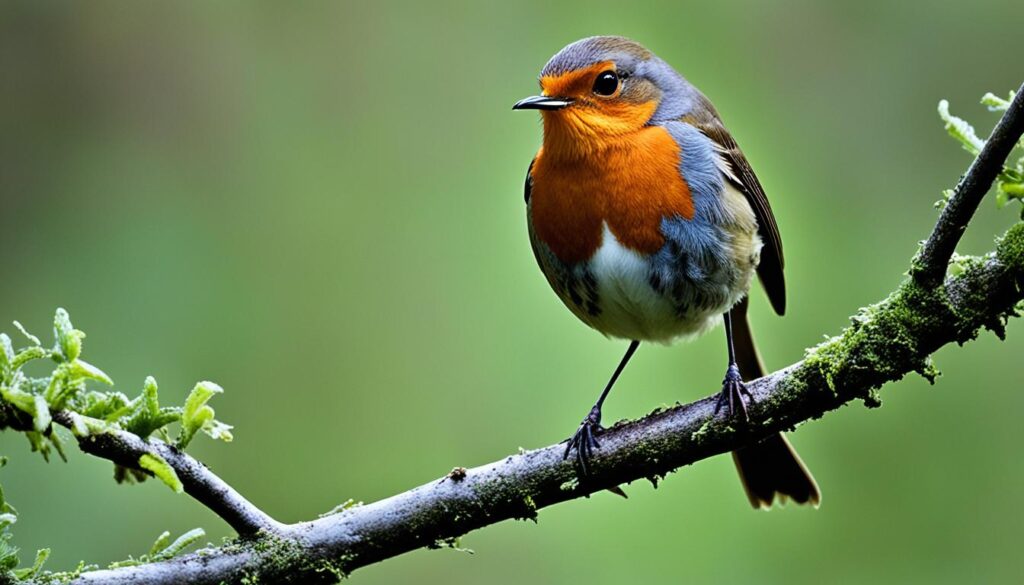
Earthworms brought from Europe have had mixed effects, helping gardens but hurting forests. Robins help control earthworm populations, keeping them in check in the ecosystem.
The Woodcock’s Peculiar Walk
Woodcocks are known for their unique walking style. They move with a special “rocking” motion on the ground. This behavior has caught the interest of birdwatchers and scientists for a long time.
Some think the woodcocks walk this way to make worms and other small creatures come up from the ground. But, they keep doing this even when the ground is frozen and the worms are too deep. This makes us wonder, what’s the real reason for their walk?
Another idea is that the woodcock’s walk is a way to warn predators. It tells them the bird knows they’re there and is ready to fly away. Woodcocks do this more in open areas where they’re more visible and less in woods where they’re hidden.
“The peculiar rocking walk of woodcocks is hypothesized to be a deliberate conspicuous behavior to predators indicating awareness and readiness to flee, instead of resorting to energetically demanding activities like flight.”
The true reason for the woodcock’s walk is still being studied. But, it’s clear this behavior is interesting in how birds forage and signal to others. More research is needed to understand how this walk helps woodcocks survive and reproduce.
What Birds Eat Worms?
Not all birds eat worms, but some species love them. These birds are called vermivores. Omnivorous birds eat both plants and animals, making them the main worm-eaters. Herbivores stick to plants, and carnivores hunt other animals, so they don’t eat worms.
Wrens, plovers, killdeers, woodcocks, thrushes, and the Eastern screech owl are some worm-eating birds. They find and catch worms to get important nutrients like protein and iron. These nutrients help with muscle and feather growth. Some birds even feed worms to their babies to help them grow strong.
Worms are a key food source for birds, especially when other food is hard to find.
Most omnivorous birds easily find and eat worms. But, some ground-dwelling birds also eat fruits and seeds. The American robin is one such bird. It uses its vision and touch to find worms in the ground.
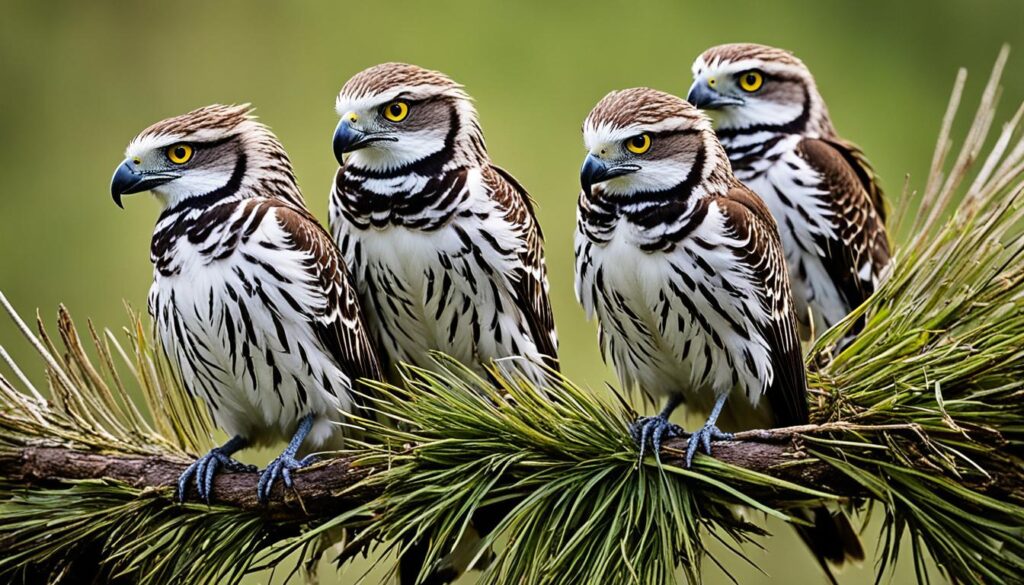
Feeding worms to pet birds is okay, but wild birds can catch their own food. If you have bird-related questions or problems, talk to professional wildlife services. They can help with local laws and make sure you’re doing the right thing.
Nutritional Value of Worms for Birds
Worms are a great food for birds that eat both plants and animals. They add a lot of protein to a bird’s diet. This is key for birds that mainly eat plants like seeds. Worms give them important minerals and vitamins like calcium and iron, which help with muscle and feather growth.
Young birds need a lot of protein to grow big and strong. That’s why some birds, like parents feeding their babies, eat worms. Live mealworms are full of protein, which is vital for baby birds to grow well.
“One customer was able to triple the population of House Sparrows in their local area over a four-year period by feeding live mealworms throughout the breeding and fledging seasons.”
Birds molt, or shed and replace their feathers, every year after they breed. This process needs a lot of protein. Worms are a key part of a bird’s diet during this time, helping with importance of worms in avian diets.
When it doesn’t rain much, birds that eat from the ground have a hard time finding food. Worms as bird food become very important for them. Feeding live mealworms in the spring helps many garden birds breed more successfully.
Putting live worms in a feeder or a shallow dish makes it easy for birds to eat them. This helps with their muscle and feather health. By knowing how protein-rich diet for birds worms are, bird lovers can make sure their birds get the nutrients they need.
Benefits of Worms in a Bird’s Diet
Worms are a great source of protein and food for birds. They are especially important for omnivorous birds when other food is hard to find. Birds that eat worms in their diets can keep eating even when other food is scarce. They also seem to like the taste of worms, even though we can’t be sure exactly why.
The importance of worms in avian nutrition is huge. They give birds high-quality protein, healthy fats, and important vitamins and minerals. These nutrients help birds stay healthy and survive.
Worms also play a big part in helping birds survive. When there’s not much other food around, worms can be a steady food source. This is very important during hard times or when birds’ homes are changed, helping them adapt and survive.
“Worms are not just a tasty treat for birds – they are a vital component of a healthy, balanced diet that supports the long-term wellbeing and survival of many avian species.”
In summary, worms have many benefits for birds. They give essential nutrients and are a steady food source when food is scarce. Understanding the role of worms in bird diets helps us see how all living things are connected.
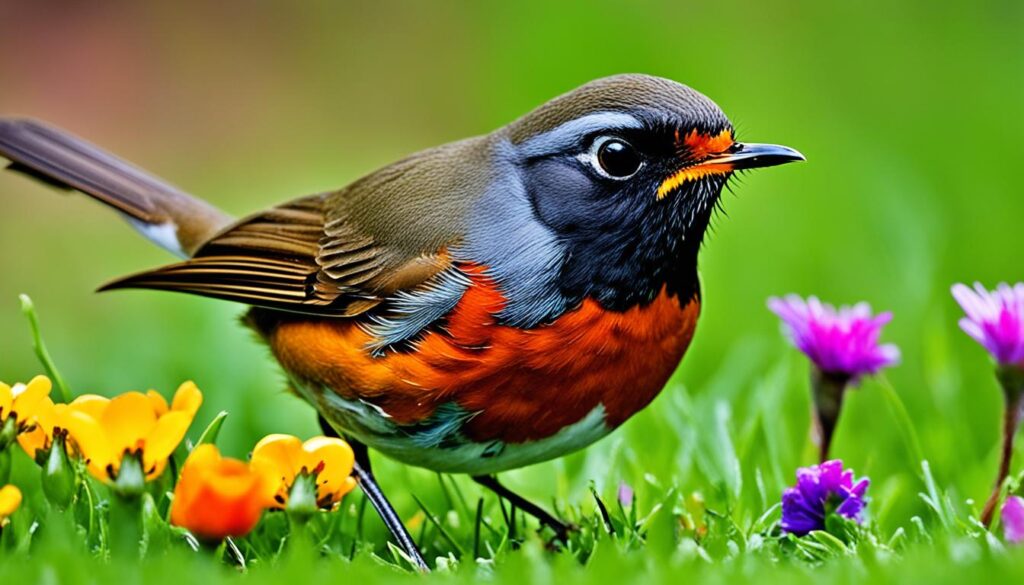
How Birds Locate Worms
Birds have a special way to find and catch worms. They use their avian sensory perception to do this. Their sense of sight is key in finding worms.
Birds have monocular vision, which lets them use each eye separately. This means they can look at the ground with one eye while keeping the other eye on something else. This helps them spot worm tails in the soil.
When a bird sees a worm, it uses its sense of touch through the feet to feel the worm move. They also listen for low-pitched noises from the soil. These sounds help them find the worm more easily.
The American Robin uses a smart way to hunt. It makes short runs or hops followed by brief pauses. During these pauses, it looks carefully for any worm movement. This role of sight in bird feeding habits is key to their hunting success.
“Robins likely rely on visual cues and use the brief standing still pose to search for subtle worm movements before attacking.”
Birds use their senses together to find and catch worms. This shows how well birds have adapted to find their favorite food.
Feeding Worms to Pet Birds
If you have a pet bird that eats worms, you can give them this food. Worms are sold in pet stores, perfect for lizards and other pets. But, wild birds can catch their own worms and don’t need our help. So, it’s best not to feed worms to wild birds as they find their own food.
For pet birds, make sure to give the right kind of worms. Mealworms are loved by many birds like chickadees and cardinals. Some bird lovers even grow their own mealworms because store-bought ones can be pricey and low quality.
“Mealworms can be effectively stored in a cool environment like a refrigerator to preserve them for extended periods.”
Feeding worms to pet birds has its perks but also risks. Buying mealworms in large amounts can be expensive. You also need to keep them safe from birds like sparrows and starlings. This might mean using special ways to keep them away.
- Mealworms are a nutritious food source for birds, providing essential nutrients like protein, potassium, and vitamins.
- Offering a suitable daily amount of around 100 mealworms can greatly benefit birds, especially during the winter and nesting seasons.
- Live mealworms are generally preferred by birds over dried ones due to their juiciness, but dried mealworms tend to be more cost-effective.
In conclusion, feeding worms to pet birds is good for them, but pick the right worms and be aware of the risks. Knowing the benefits and how to feed them right helps pet owners take great care of their birds.
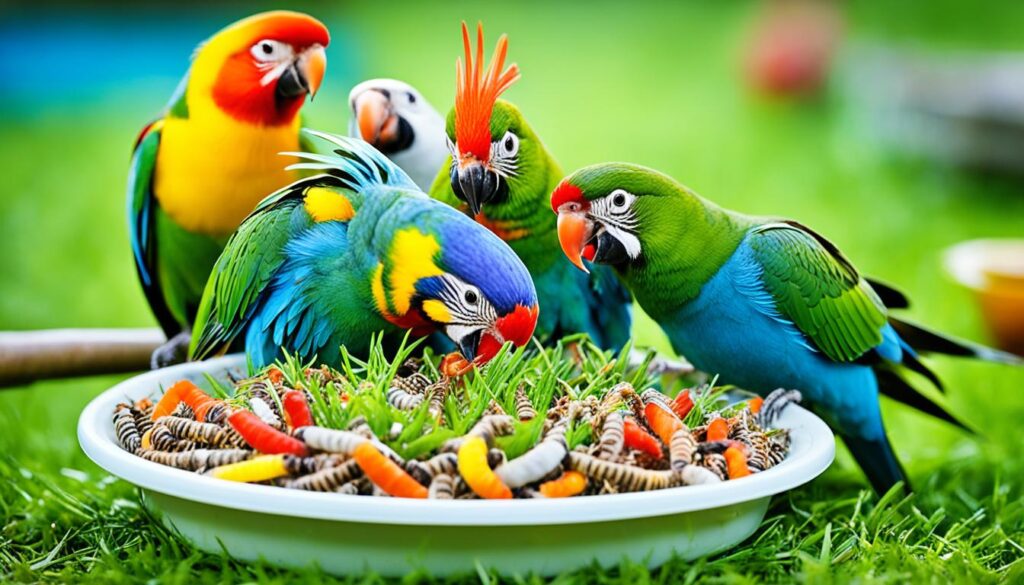
Conclusion
Birds show a wide range of eating habits, from eating worms to plants. This variety shows how adaptable and strong birds are. Their eating habits match their body features and help keep ecosystems balanced.
Learning about how different birds eat helps us understand nature better. For example, birds that eat worms show how important worms are in nature. Watching these birds can tell us about the health of worms and the soil they live in.
Studying birds and their diets shows us why we need to protect their homes. Keeping different habitats safe helps keep the balance in nature. By caring for birds, worms, and nature, we can keep our world rich and full of life.
FAQ
What is a vermivore?
“Vermivore” is a term for animals that eat worms and similar creatures. This includes segmented worms, roundworms, and insect larvae.
Why are birds drawn to worms?
Birds like worms because they are high in protein. They are also easy to find by simply sticking their bills into the soil.
Are mealworms considered true worms?
No, mealworms are not worms. They are actually the larval stage of the darkling beetle. But they look like worms, so birds that eat them are still called vermivores.
What are some examples of vermivore bird species?
Some birds that eat worms include woodpeckers, nuthatches, robins, starlings, owls, and bluebirds.
What are some examples of seedeater bird species?
Birds that eat seeds include finches, cardinals, chickadees, redpolls, and juncos.
How do robins locate worms?
Robins don’t use smell or hearing to find worms. They use their sight. They dig small holes and look for worms in them.
What is the purpose of the woodcock’s distinctive walk?
The woodcock’s walk was thought to help find worms. But studies show it’s also done on frozen ground. It might warn predators that the bird knows they’re there.
What types of birds eat worms?
Only omnivorous birds eat worms. They eat both plants and animals. Herbivores eat only plants, and carnivores eat only meat.
What are the nutritional benefits of worms for birds?
Worms are very nutritious for birds. They give them protein and important minerals and vitamins. These help with muscle and feather growth.
How do birds locate and catch worms?
Birds use vision, hearing, and touch to find and catch worms. But they mostly rely on sight. They can move their eyes independently to see better.
Should I feed worms to wild birds?
Wild birds can catch their own worms. They don’t need help from humans. So, it’s best not to feed them worms.
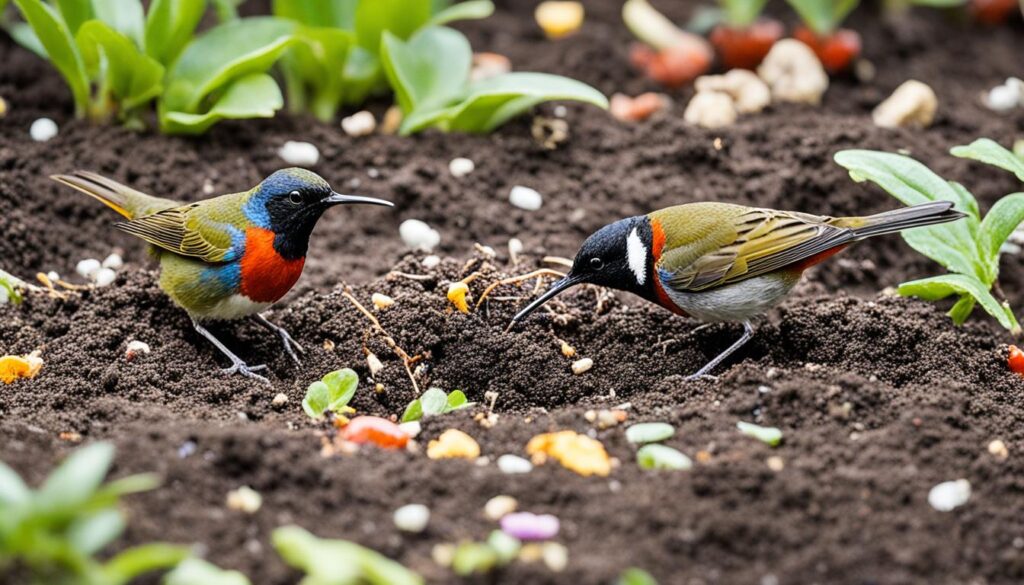

купить аккаунт площадка для продажи аккаунтов
маркетплейс для реселлеров перепродажа аккаунтов
продажа аккаунтов соцсетей площадка для продажи аккаунтов
площадка для продажи аккаунтов биржа аккаунтов
платформа для покупки аккаунтов продать аккаунт
перепродажа аккаунтов маркетплейс аккаунтов соцсетей
продажа аккаунтов аккаунты с балансом
продажа аккаунтов https://birzha-akkauntov-online.ru
услуги по продаже аккаунтов https://marketplace-akkauntov-top.ru/
купить аккаунт с прокачкой маркетплейс для реселлеров
продать аккаунт купить аккаунт
маркетплейс аккаунтов профиль с подписчиками
продажа аккаунтов соцсетей магазин аккаунтов
купить аккаунт маркетплейс аккаунтов
Secure Account Purchasing Platform Account market
Secure Account Sales Account trading platform
Marketplace for Ready-Made Accounts Website for Selling Accounts
Social media account marketplace Account Trading
Account Sale Purchase Ready-Made Accounts
Online Account Store Account Trading
Online Account Store Purchase Ready-Made Accounts
Ready-Made Accounts for Sale Sell Account
Social media account marketplace Account Trading
Account trading platform Secure Account Sales
Sell Pre-made Account Sell accounts
account sale https://cheapaccountsmarket.com
buy accounts secure account purchasing platform
secure account purchasing platform website for selling accounts
account sale sell account
account store account sale
website for selling accounts account selling service
secure account purchasing platform socialaccountsdeal.com
website for buying accounts account market
account purchase buy account
secure account purchasing platform account trading platform
online account store https://accounts-marketplace.org/
secure account purchasing platform marketplace for ready-made accounts
online account store account sale
buy pre-made account https://accounts-buy.org
secure account sales accounts for sale
website for selling accounts https://buy-social-accounts.org
buy and sell accounts profitable account sales
account trading platform https://buy-online-accounts.org
account trading service accounts marketplace
account market account store
guaranteed accounts sell pre-made account
gaming account marketplace account buying service
marketplace for ready-made accounts social media account marketplace
purchase ready-made accounts online account store
account trading purchase ready-made accounts
account marketplace ready-made accounts for sale
sell account sell account
sell pre-made account https://accounts-offer.org
account catalog https://accounts-marketplace.xyz
buy pre-made account accounts market
account catalog account market
secure account purchasing platform https://accounts-marketplace.live
account acquisition https://social-accounts-marketplace.xyz/
profitable account sales https://buy-accounts.space
sell accounts buy accounts
buy accounts https://accounts-marketplace.art
secure account purchasing platform https://social-accounts-marketplace.live
account store account market
account trading platform https://accounts-marketplace.online
account exchange https://accounts-marketplace-best.pro
маркетплейс аккаунтов akkaunty-na-prodazhu.pro
магазин аккаунтов https://kupit-akkaunt.xyz
маркетплейс аккаунтов rynok-akkauntov.top
площадка для продажи аккаунтов https://akkaunt-magazin.online
покупка аккаунтов https://akkaunty-market.live/
площадка для продажи аккаунтов https://kupit-akkaunty-market.xyz/
маркетплейс аккаунтов соцсетей akkaunty-optom.live
магазин аккаунтов купить аккаунт
биржа аккаунтов https://akkaunty-dlya-prodazhi.pro/
маркетплейс аккаунтов соцсетей kupit-akkaunt.online
buying fb accounts buy fb ad account
buy facebook profile https://buy-ad-account.top/
buying fb accounts facebook ad account for sale
facebook ad account buy ad-account-buy.top
buy a facebook ad account https://buy-ads-account.work
facebook account sale buy facebook accounts cheap
facebook ads account for sale facebook ad account for sale
buy facebook account for ads https://ad-accounts-for-sale.work
buy google ads threshold accounts buy verified google ads account
buy fb account fb account for sale
buy adwords account https://buy-ads-accounts.click
buy verified google ads account https://ads-account-for-sale.top
google ads accounts for sale https://ads-account-buy.work
google ads accounts for sale buy google ads threshold account
buy google ads accounts buy verified google ads account
buy google agency account buy google ads invoice account
buy google ads invoice account https://buy-verified-ads-account.work/
business manager for sale buy-business-manager.org
buy google agency account buy google ads